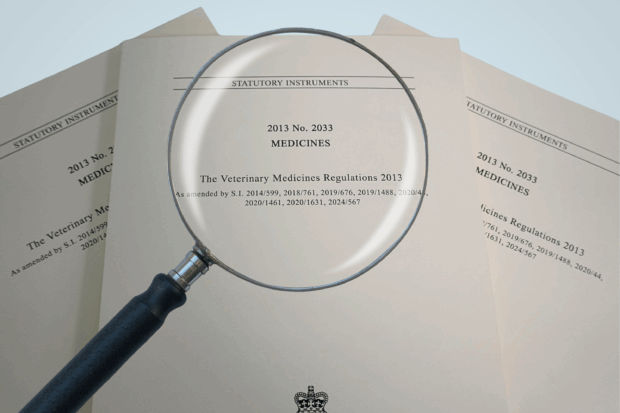
As Head of Inspections and Enforcement at the Veterinary Medicines Directorate (VMD), I regularly see how veterinary practices manage controlled drugs (CDs). Through our programme of inspections, we've identified several areas where practices commonly face challenges. I'd like to share some insights to help practices maintain compliance and ensure the safe use of these vital medicines.
Veterinary surgeon’s responsibilities
It is the vet's responsibility to make sure that CDs at the practice they work at are stored, used and supplied correctly. While you may delegate certain tasks to your team, such as recording entries in the CD register or having access to the CD cabinet, you retain ultimate accountability for:
- Ordering controlled drugs
- Maintaining accurate records
- Ensuring secure storage
- Putting appropriate checks in place to prevent medicine misuse
- Overseeing proper disposal
Schedule 2 and 3 CDs
Schedule 2 and 3 CDs can only be supplied against a valid CD requisition order that must be hand signed by a registered vet. You should not request a CD without completing the relevant requisition order form. If you are supplied with the medicine without completing the relevant form, please ensure you report this to us at postmaster@vmd.gov.uk so we can investigate further.
CD Registers
During inspections, we will always ask to see your CD registers. A register is required for ALL Schedule 2 CDs such as methadone, ketamine and quinalbarbitone. A register must be kept for each product in each area where it is being stored. This is so that it is easy for you to check what stock you should have against the stock you do have.
Your register must be either:
- A dedicated bound book
- An electronic system that meets regulatory requirements and prevents records being amended in any way.
Essential register requirements
For bound books you must ensure:
- it is separated into each class of drug
- there is a separate page for each strength and form of that drug, with this recorded at the top of each page
- entries are in ink
- any errors are crossed through with a single line and amendments made to the side, no obliterations
- ensure any corrections are made by a signed and dated entry in the margin or at the bottom of the page
- entries are in date order
- it is kept at the premises it relates to
- it is not used for any other purpose
- it is kept for at least 2 years from the date of the last entry
What do we check during vet practice inspections
At an inspection we will check your CD register and we will expect to see certain bits of information.
For incoming stock, we need to see:
- Date it arrived
- Who supplied you
- The product details
- How much you received
It is also good practice to record who has made the entry and the new running balance.
For outgoing stock, we need to see:
- Date of supply/administration
- Who has been supplied, so the animal identification
- How much was administered/supplied
It is also good practice to record who made the entry and the prescribing vet, the probable hub wastage and the new running balance.
Stock discrepancies
Getting the running balance correct is challenging for vet practices. This can be for several reasons such as:
- Volumes used will often be very low
- With every draw there will be a small amount of needle / hub wastage
- Drawing up accuracy (training staff)
- Slightly over/under filled bottles or bottle leakage
- Challenging situations when using the product (in a field on a farm or in surgery)
What to do when discrepancies arise
If you do not have an accurate balance at the end of a bottle you must review and investigate the discrepancies by following these steps:
- Review hub wastage calculations
- Verify dose records against clinical notes
- Audit running balance calculations
- Consult members of staff who have had access to the cabinet
If you have concerns over a discrepancy, you should report this to the police due to the potential for misuse, particularly if a full bottle has gone missing. You may also need to review who has access to the CD cabinet.
Secure CD storage
Certain controlled drugs are required to be kept in a CD cabinet that complies with the Misuse of Drugs Regulations. These are:
- All Schedule 2 CDs (excluding Quinalbarbitone – Somulose)
- Certain Schedule 3 CDs such as:
- Buprenorphine
- Diethylpropion
- Flunitrazepam
- Temazepam
It is good practice to store all controlled drugs securely, particularly any that may be open to abuse.
The Misuse of Drugs Regulations has very specific requirements for CD cabinets, covering how thick the metal must be to the types of lock that can be used. It is your responsibility to ensure your cabinet meets the requirements. Please refer to the Home Office guidance to ensure your cabinet meets the required specifications.
Witness Disposal
All schedule 2 controlled drugs that are out of date must be disposed of appropriately and in the presence of an independent witness. This also applies to schedules 3 and 4 CDs that have been prepared extemporaneously for use under the Cascade.
The leftover medicines must be made irretrievable and the best way to do this is to use a CD disposal kit. In GB an approved witness can be:
- an inspector appointed under the Veterinary Medicines Regulations 2013 (as amended) (VMR)
- a vet, independent of the practice where the disposal takes place
- a person legally authorised to witness the destruction of CDs such as a Police CD Liaison Officer (CDLO)
In Northern Ireland, destruction can only be carried out in the presence of a person legally authorised by the Northern Ireland Department of Health.
For detailed information and to ensure you and your practice remain compliant with all regulations, consult:
Leave a comment